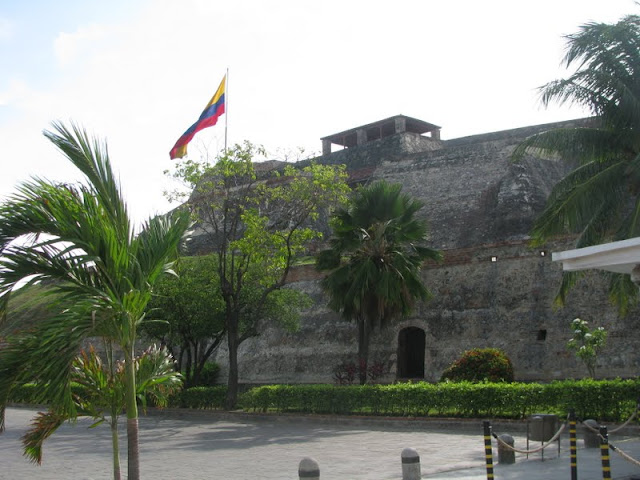The Castillo San Felipe de Barajas is a fortress in the city of Cartagena, Colombia. The castle is  located on the Hill of San Lázaro in a strategic location, dominating approaches to the city by land or sea. It was built by the Spanish during the colonial era. Construction began in the year 1536, and it was originally known as the Castillo de San Lázaro, It was expanded in 1657.
located on the Hill of San Lázaro in a strategic location, dominating approaches to the city by land or sea. It was built by the Spanish during the colonial era. Construction began in the year 1536, and it was originally known as the Castillo de San Lázaro, It was expanded in 1657.
The fortress was begun in 1536. It was significantly expanded in 1657. It was built in a triangular shape on top of the hill, with eight guns and a garrison of 20 soldiers and 4 gunners. It was named was given in honour of Philip IV of Spain. Another expansion was made to the fortress in 1763 by Antonio de Arévalo.
In the 1697 raid on Cartagena, during the War of the Grand Alliance, the castle fell to the French privateer Baron de Pointis. The castle was repaired by José de Herrera y Sotomayor in 1739. British Admiral Edward Vernon attacked the fortress in the 1741 Battle of Cartagena de Indias, an important conflict of the War of Jenkins' Ear. Vernon's forces were repelled by the Spanish admiral Blas de Lezo.
The castle is well preserved. When it ceased to be used for military purposes, tropical vegetation covered the battlements and walls, and soil accumulated in the tunnels and trenches.
In 1984, UNESCO listed the castle, with the historic centre of the city of Cartagena, as a World Heritage Site. Since 1990, the castle has served as a location for social and cultural events offered by the Colombian government in honour of foreign delegations at presidential summits, ministerial meetings, the Summit of the Non-Aligned Movement (1995) and the Summit of the Rio Group (2000), among others.
The castle is open to visitors.
The fortress was begun in 1536. It was significantly expanded in 1657. It was built in a triangular shape on top of the hill, with eight guns and a garrison of 20 soldiers and 4 gunners. It was named was given in honour of Philip IV of Spain. Another expansion was made to the fortress in 1763 by Antonio de Arévalo.
In the 1697 raid on Cartagena, during the War of the Grand Alliance, the castle fell to the French privateer Baron de Pointis. The castle was repaired by José de Herrera y Sotomayor in 1739. British Admiral Edward Vernon attacked the fortress in the 1741 Battle of Cartagena de Indias, an important conflict of the War of Jenkins' Ear. Vernon's forces were repelled by the Spanish admiral Blas de Lezo.
The castle is well preserved. When it ceased to be used for military purposes, tropical vegetation covered the battlements and walls, and soil accumulated in the tunnels and trenches.
In 1984, UNESCO listed the castle, with the historic centre of the city of Cartagena, as a World Heritage Site. Since 1990, the castle has served as a location for social and cultural events offered by the Colombian government in honour of foreign delegations at presidential summits, ministerial meetings, the Summit of the Non-Aligned Movement (1995) and the Summit of the Rio Group (2000), among others.
The castle is open to visitors.
You have read this article with the title CASTILLO SAN FELIPE DE BARAJAS, CARTAGENA DE INDIAS, COLOMBIA. You can bookmark this page URL https://tiogatalk.blogspot.com/2011/05/castillo-san-felipe-de-barajas.html. Thanks!
Write by:
AN - Tuesday, May 17, 2011










Comments "CASTILLO SAN FELIPE DE BARAJAS, CARTAGENA DE INDIAS, COLOMBIA"
Post a Comment